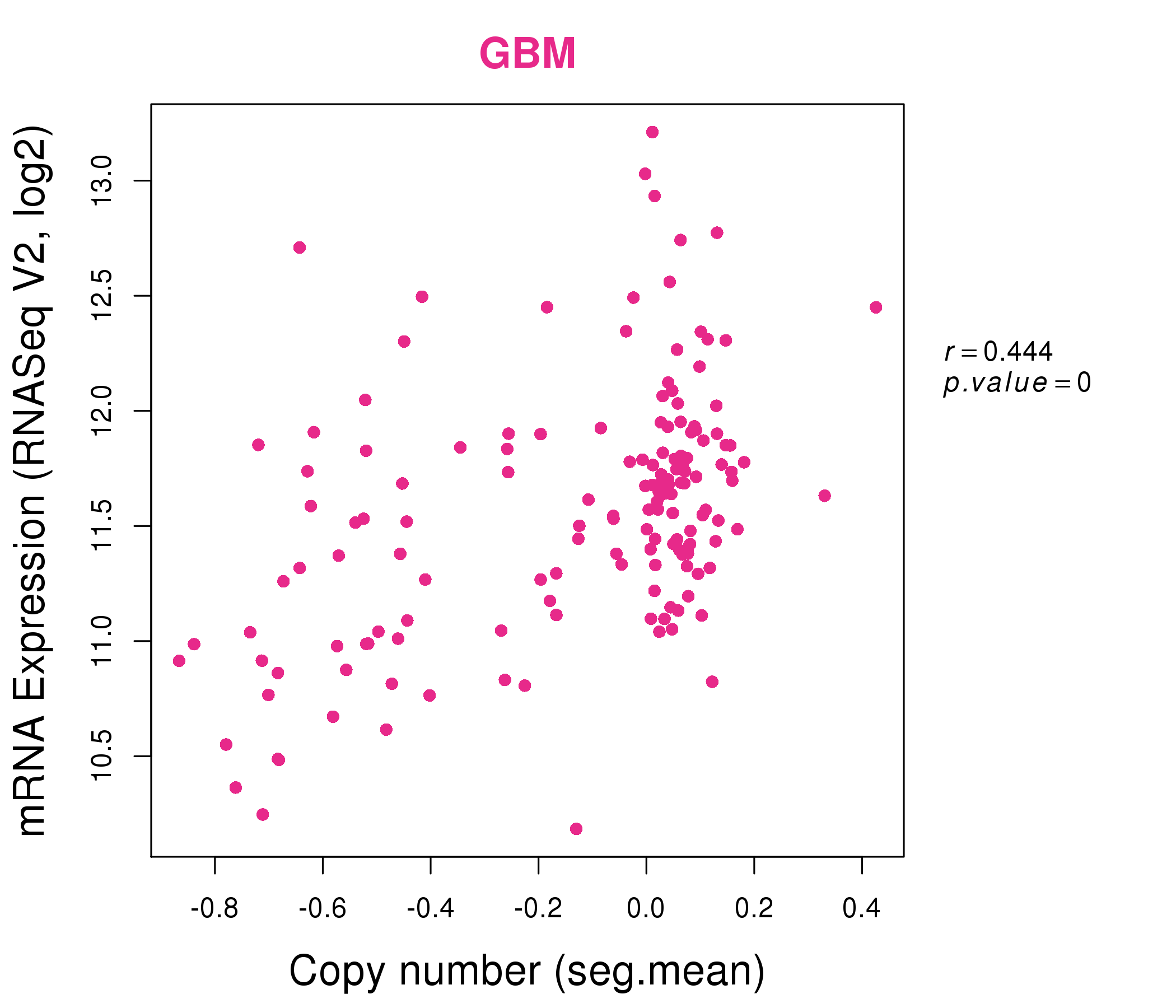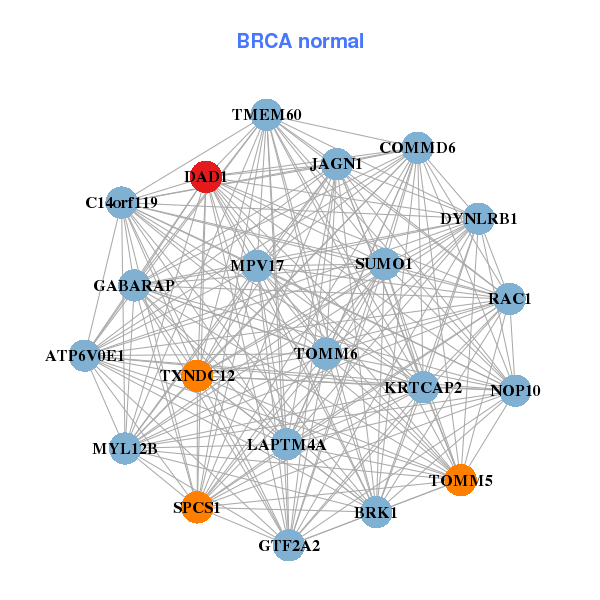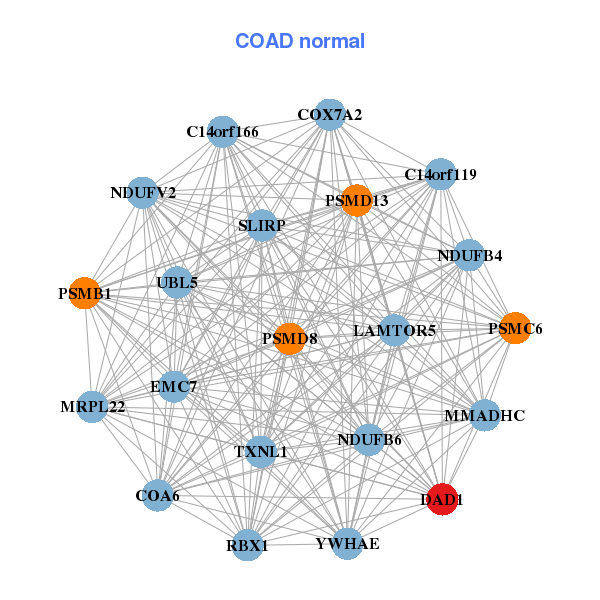|
||||||||||||||||||||
| |
| Phenotypic Information (metabolism pathway, cancer, disease, phenome) |
| |
| |
| Gene-Gene Network Information: Co-Expression Network, Interacting Genes & KEGG |
| |
|
| Gene Summary for DAD1 |
| Basic gene info. | Gene symbol | DAD1 |
| Gene name | defender against cell death 1 | |
| Synonyms | OST2 | |
| Cytomap | UCSC genome browser: 14q11.2 | |
| Genomic location | chr14 :23033806-23058143 | |
| Type of gene | protein-coding | |
| RefGenes | NM_001344.3, | |
| Ensembl id | ENSG00000129562 | |
| Description | DAD-1dolichyl-diphosphooligosaccharide--protein glycosyltransferase subunit DAD1oligosaccharyl transferase subunit DAD1oligosaccharyltransferase 2 homologoligosaccharyltransferase subunit 2 (non-catalytic) | |
| Modification date | 20141207 | |
| dbXrefs | MIM : 600243 | |
| HGNC : HGNC | ||
| Ensembl : ENSG00000129562 | ||
| HPRD : 02589 | ||
| Vega : OTTHUMG00000028685 | ||
| Protein | UniProt: go to UniProt's Cross Reference DB Table | |
| Expression | CleanEX: HS_DAD1 | |
| BioGPS: 1603 | ||
| Gene Expression Atlas: ENSG00000129562 | ||
| The Human Protein Atlas: ENSG00000129562 | ||
| Pathway | NCI Pathway Interaction Database: DAD1 | |
| KEGG: DAD1 | ||
| REACTOME: DAD1 | ||
| ConsensusPathDB | ||
| Pathway Commons: DAD1 | ||
| Metabolism | MetaCyc: DAD1 | |
| HUMANCyc: DAD1 | ||
| Regulation | Ensembl's Regulation: ENSG00000129562 | |
| miRBase: chr14 :23,033,806-23,058,143 | ||
| TargetScan: NM_001344 | ||
| cisRED: ENSG00000129562 | ||
| Context | iHOP: DAD1 | |
| cancer metabolism search in PubMed: DAD1 | ||
| UCL Cancer Institute: DAD1 | ||
| Assigned class in ccmGDB | C | |
| Top |
| Phenotypic Information for DAD1(metabolism pathway, cancer, disease, phenome) |
| Cancer | CGAP: DAD1 |
| Familial Cancer Database: DAD1 | |
| * This gene is included in those cancer gene databases. |
|
|
|
|
|
| . | ||||||||||||||
Oncogene 1 | Significant driver gene in | |||||||||||||||||||
| cf) number; DB name 1 Oncogene; http://nar.oxfordjournals.org/content/35/suppl_1/D721.long, 2 Tumor Suppressor gene; https://bioinfo.uth.edu/TSGene/, 3 Cancer Gene Census; http://www.nature.com/nrc/journal/v4/n3/abs/nrc1299.html, 4 CancerGenes; http://nar.oxfordjournals.org/content/35/suppl_1/D721.long, 5 Network of Cancer Gene; http://ncg.kcl.ac.uk/index.php, 1Therapeutic Vulnerabilities in Cancer; http://cbio.mskcc.org/cancergenomics/statius/ |
| REACTOME_METABOLISM_OF_PROTEINS | |
| OMIM | |
| Orphanet | |
| Disease | KEGG Disease: DAD1 |
| MedGen: DAD1 (Human Medical Genetics with Condition) | |
| ClinVar: DAD1 | |
| Phenotype | MGI: DAD1 (International Mouse Phenotyping Consortium) |
| PhenomicDB: DAD1 | |
| Mutations for DAD1 |
| * Under tables are showing count per each tissue to give us broad intuition about tissue specific mutation patterns.You can go to the detailed page for each mutation database's web site. |
| There's no structural variation information in COSMIC data for this gene. |
| * From mRNA Sanger sequences, Chitars2.0 arranged chimeric transcripts. This table shows DAD1 related fusion information. |
| ID | Head Gene | Tail Gene | Accession | Gene_a | qStart_a | qEnd_a | Chromosome_a | tStart_a | tEnd_a | Gene_a | qStart_a | qEnd_a | Chromosome_a | tStart_a | tEnd_a |
| AI094624 | DAD1 | 28 | 339 | 14 | 23033807 | 23044039 | YWHAE | 337 | 515 | 17 | 1265241 | 1268269 | |
| BE537940 | GNB1 | 199 | 249 | 1 | 1717104 | 1717154 | DAD1 | 249 | 575 | 14 | 23044093 | 23058136 | |
| BC013646 | GNB1 | 215 | 268 | 1 | 1717101 | 1717154 | DAD1 | 268 | 959 | 14 | 23033805 | 23058136 | |
| Top |
| There's no copy number variation information in COSMIC data for this gene. |
| Top |
|
 |
| Top |
| Stat. for Non-Synonymous SNVs (# total SNVs=6) | (# total SNVs=0) |
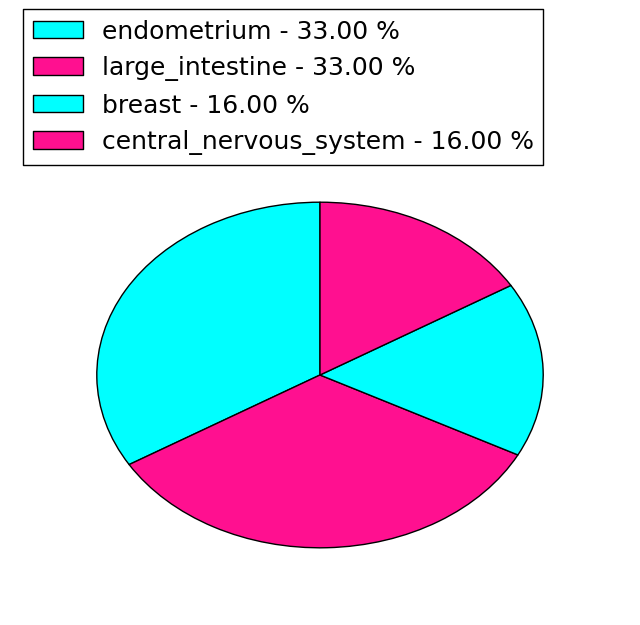 | |
(# total SNVs=3) | (# total SNVs=0) |
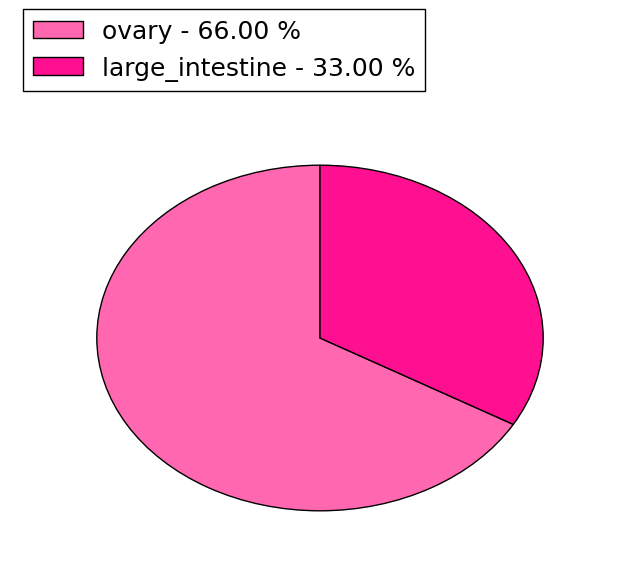 |
| Top |
| * When you move the cursor on each content, you can see more deailed mutation information on the Tooltip. Those are primary_site,primary_histology,mutation(aa),pubmedID. |
| GRCh37 position | Mutation(aa) | Unique sampleID count |
| chr14:23057891-23057891 | p.S58L | 1 |
| chr14:23057896-23057897 | p.F56fs*40 | 1 |
| chr14:23057900-23057900 | p.S55Y | 1 |
| chr14:23058005-23058005 | p.T20N | 1 |
| chr14:23058021-23058021 | p.E15K | 1 |
| chr14:23058038-23058038 | p.I9S | 1 |
| chr14:23044008-23044010 | p.V112delV | 1 |
| chr14:23058043-23058044 | p.S7fs*89 | 1 |
| chr14:23044032-23044032 | p.H105Y | 1 |
| chr14:23044071-23044071 | p.R92* | 1 |
| Top |
|
 |
| Point Mutation/ Tissue ID | 1 | 2 | 3 | 4 | 5 | 6 | 7 | 8 | 9 | 10 | 11 | 12 | 13 | 14 | 15 | 16 | 17 | 18 | 19 | 20 |
| # sample | 2 | 1 | 1 | 1 | ||||||||||||||||
| # mutation | 2 | 1 | 1 | 1 | ||||||||||||||||
| nonsynonymous SNV | 2 | 1 | 1 | 1 | ||||||||||||||||
| synonymous SNV |
| cf) Tissue ID; Tissue type (1; BLCA[Bladder Urothelial Carcinoma], 2; BRCA[Breast invasive carcinoma], 3; CESC[Cervical squamous cell carcinoma and endocervical adenocarcinoma], 4; COAD[Colon adenocarcinoma], 5; GBM[Glioblastoma multiforme], 6; Glioma Low Grade, 7; HNSC[Head and Neck squamous cell carcinoma], 8; KICH[Kidney Chromophobe], 9; KIRC[Kidney renal clear cell carcinoma], 10; KIRP[Kidney renal papillary cell carcinoma], 11; LAML[Acute Myeloid Leukemia], 12; LUAD[Lung adenocarcinoma], 13; LUSC[Lung squamous cell carcinoma], 14; OV[Ovarian serous cystadenocarcinoma ], 15; PAAD[Pancreatic adenocarcinoma], 16; PRAD[Prostate adenocarcinoma], 17; SKCM[Skin Cutaneous Melanoma], 18:STAD[Stomach adenocarcinoma], 19:THCA[Thyroid carcinoma], 20:UCEC[Uterine Corpus Endometrial Carcinoma]) |
| Top |
| * We represented just top 10 SNVs. When you move the cursor on each content, you can see more deailed mutation information on the Tooltip. Those are primary_site, primary_histology, mutation(aa), pubmedID. |
| Genomic Position | Mutation(aa) | Unique sampleID count |
| chr14:23058038 | p.H105Y | 1 |
| chr14:23044032 | p.S55Y | 1 |
| chr14:23057900 | p.P52L | 1 |
| chr14:23057909 | p.T20N | 1 |
| chr14:23058005 | p.E15K | 1 |
| chr14:23058021 | p.I9S | 1 |
| * Copy number data were extracted from TCGA using R package TCGA-Assembler. The URLs of all public data files on TCGA DCC data server were gathered on Jan-05-2015. Function ProcessCNAData in TCGA-Assembler package was used to obtain gene-level copy number value which is calculated as the average copy number of the genomic region of a gene. |
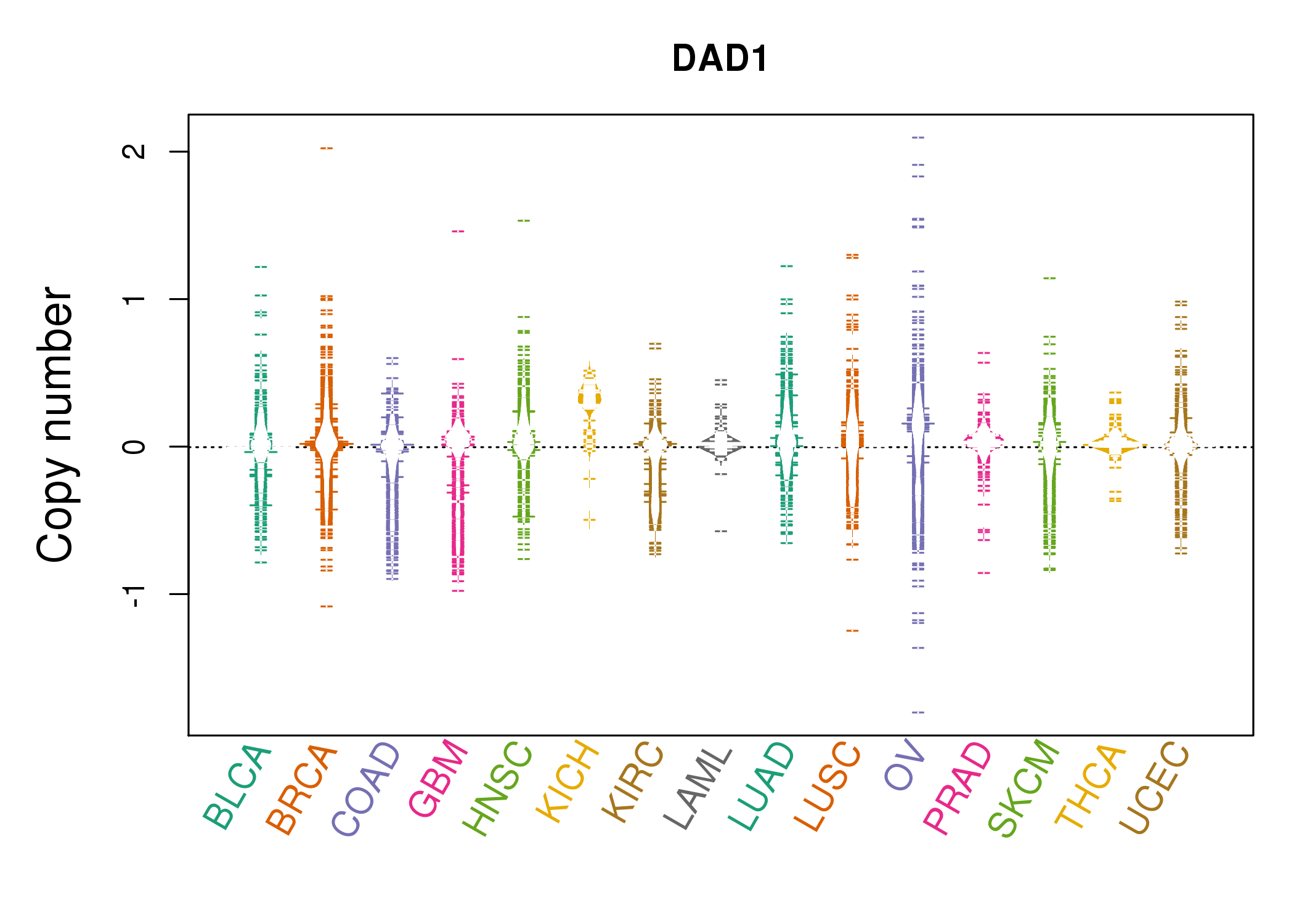 |
| cf) Tissue ID[Tissue type]: BLCA[Bladder Urothelial Carcinoma], BRCA[Breast invasive carcinoma], CESC[Cervical squamous cell carcinoma and endocervical adenocarcinoma], COAD[Colon adenocarcinoma], GBM[Glioblastoma multiforme], Glioma Low Grade, HNSC[Head and Neck squamous cell carcinoma], KICH[Kidney Chromophobe], KIRC[Kidney renal clear cell carcinoma], KIRP[Kidney renal papillary cell carcinoma], LAML[Acute Myeloid Leukemia], LUAD[Lung adenocarcinoma], LUSC[Lung squamous cell carcinoma], OV[Ovarian serous cystadenocarcinoma ], PAAD[Pancreatic adenocarcinoma], PRAD[Prostate adenocarcinoma], SKCM[Skin Cutaneous Melanoma], STAD[Stomach adenocarcinoma], THCA[Thyroid carcinoma], UCEC[Uterine Corpus Endometrial Carcinoma] |
| Top |
| Gene Expression for DAD1 |
| * CCLE gene expression data were extracted from CCLE_Expression_Entrez_2012-10-18.res: Gene-centric RMA-normalized mRNA expression data. |
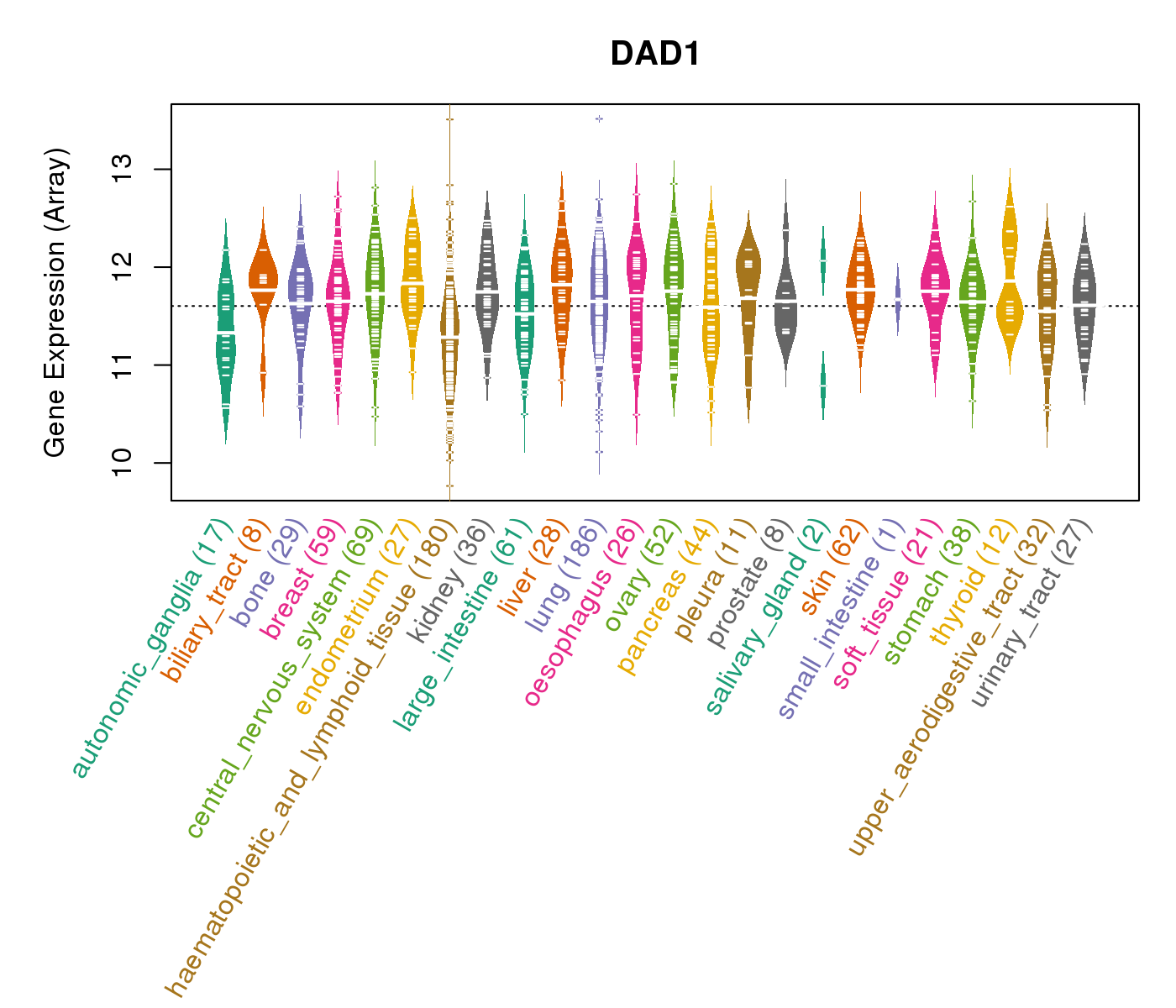 |
| * Normalized gene expression data of RNASeqV2 was extracted from TCGA using R package TCGA-Assembler. The URLs of all public data files on TCGA DCC data server were gathered at Jan-05-2015. Only eight cancer types have enough normal control samples for differential expression analysis. (t test, adjusted p<0.05 (using Benjamini-Hochberg FDR)) |
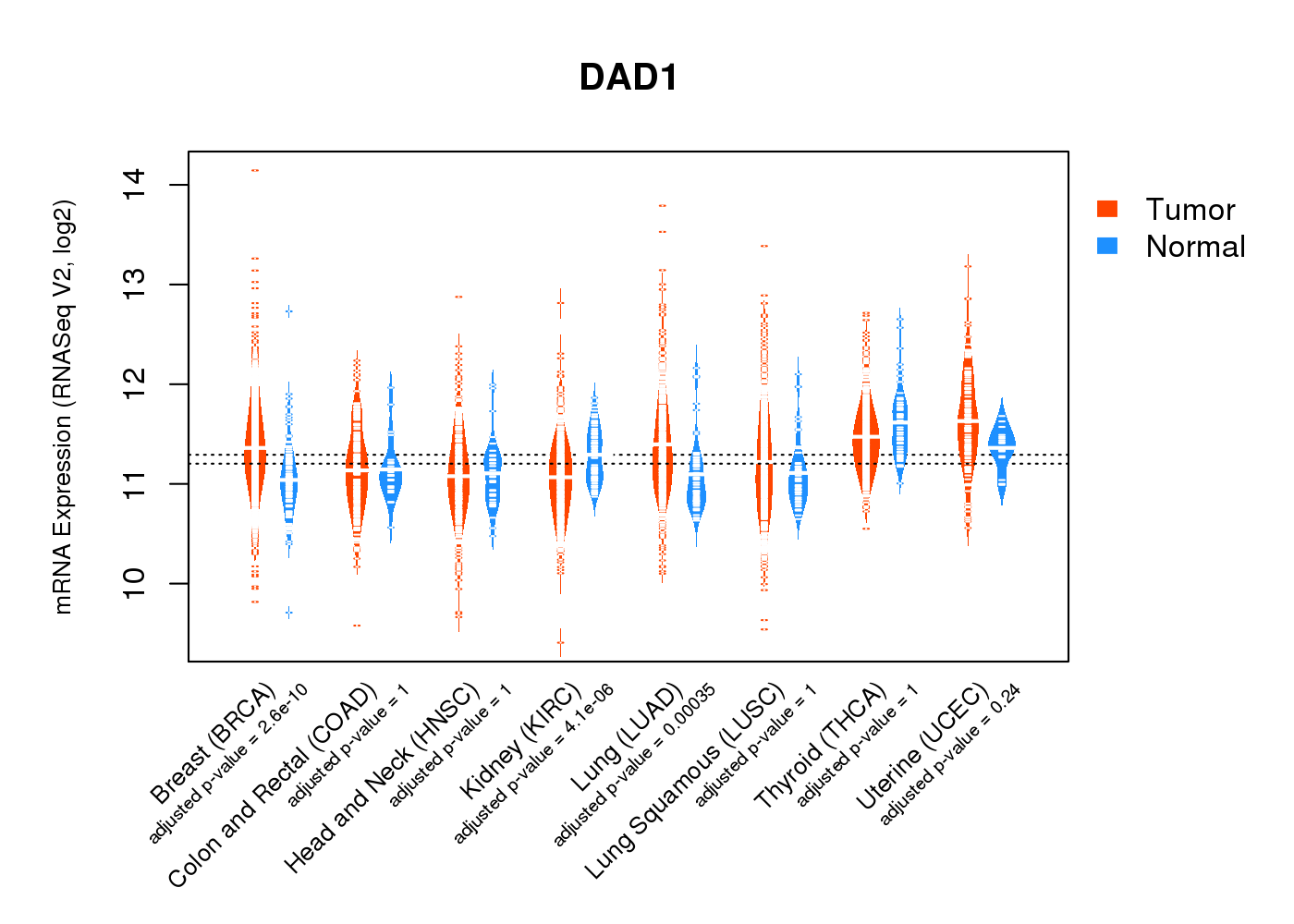 |
| Top |
| * This plots show the correlation between CNV and gene expression. |
: Open all plots for all cancer types
 |
|
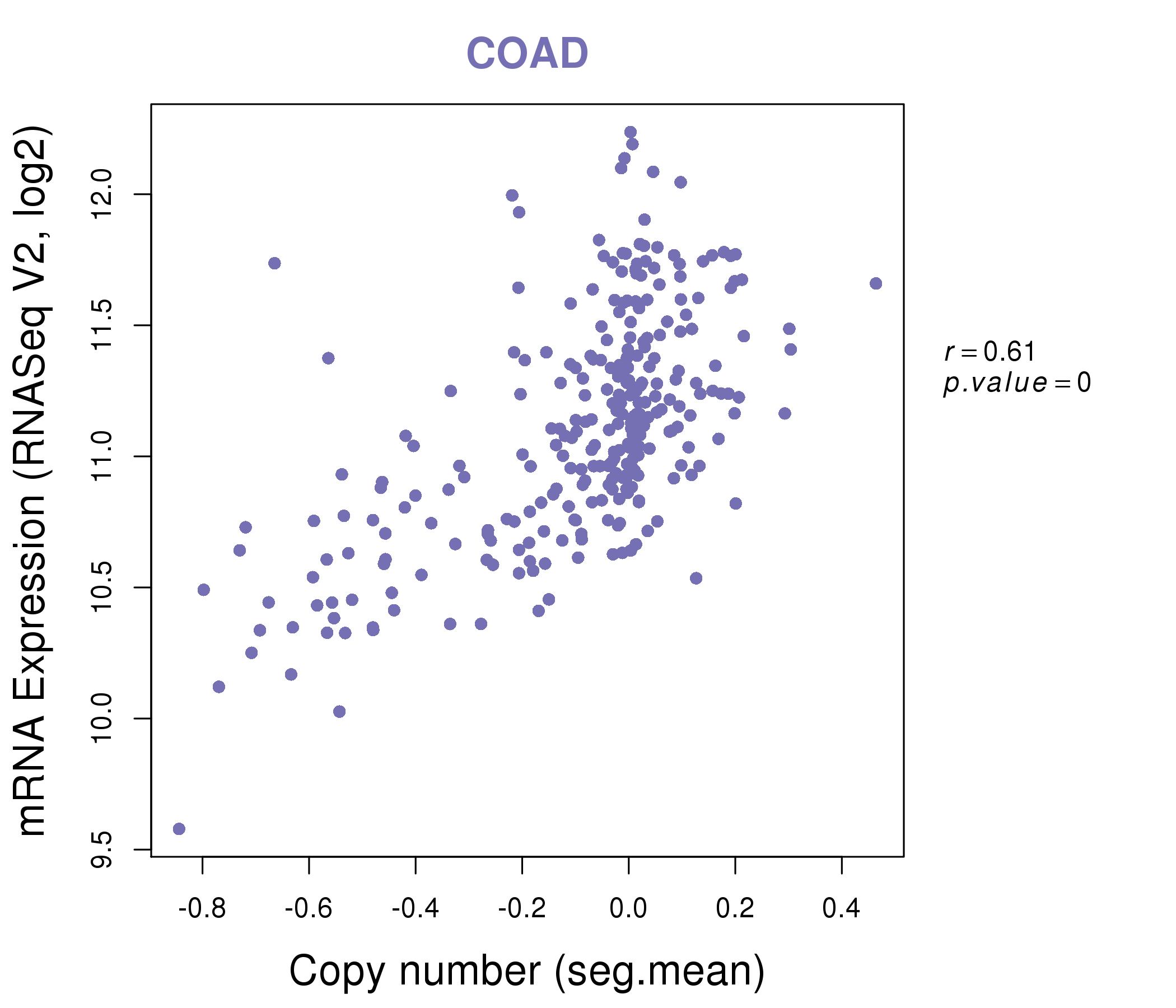 |
|
| Top |
| Gene-Gene Network Information |
| * Co-Expression network figures were drawn using R package igraph. Only the top 20 genes with the highest correlations were shown. Red circle: input gene, orange circle: cell metabolism gene, sky circle: other gene |
: Open all plots for all cancer types
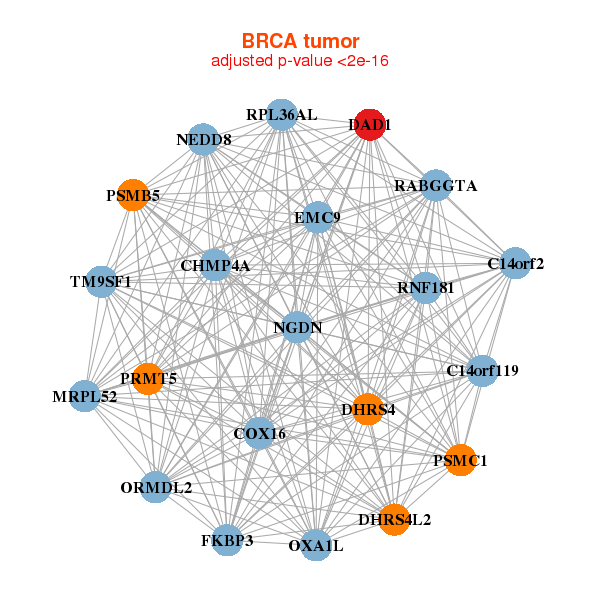 |
|
| C14orf119,C14orf2,CHMP4A,COX16,DAD1,DHRS4,DHRS4L2, EMC9,FKBP3,MRPL52,NEDD8,NGDN,ORMDL2,OXA1L, PRMT5,PSMB5,PSMC1,RABGGTA,RNF181,RPL36AL,TM9SF1 | ATP6V0E1,C14orf119,BRK1,COMMD6,DAD1,DYNLRB1,GABARAP, GTF2A2,JAGN1,KRTCAP2,LAPTM4A,MPV17,MYL12B,NOP10, RAC1,SPCS1,SUMO1,TMEM60,TOMM5,TOMM6,TXNDC12 |
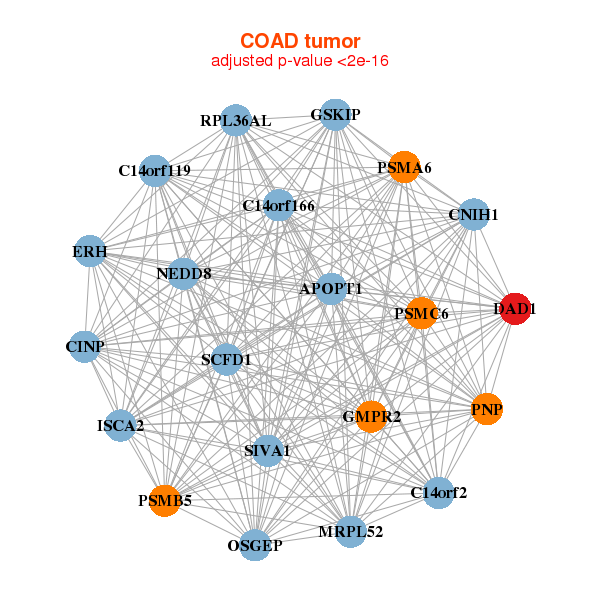 |
|
| C14orf119,GSKIP,APOPT1,C14orf166,C14orf2,CINP,CNIH1, DAD1,ERH,GMPR2,ISCA2,MRPL52,NEDD8,OSGEP, PNP,PSMA6,PSMB5,PSMC6,RPL36AL,SCFD1,SIVA1 | C14orf119,SLIRP,C14orf166,EMC7,COA6,COX7A2,DAD1, LAMTOR5,MMADHC,MRPL22,NDUFB4,NDUFB6,NDUFV2,PSMB1, PSMC6,PSMD13,PSMD8,RBX1,TXNL1,UBL5,YWHAE |
| * Co-Expression network figures were drawn using R package igraph. Only the top 20 genes with the highest correlations were shown. Red circle: input gene, orange circle: cell metabolism gene, sky circle: other gene |
: Open all plots for all cancer types
| Top |
: Open all interacting genes' information including KEGG pathway for all interacting genes from DAVID
| Top |
| Pharmacological Information for DAD1 |
| There's no related Drug. |
| Top |
| Cross referenced IDs for DAD1 |
| * We obtained these cross-references from Uniprot database. It covers 150 different DBs, 18 categories. http://www.uniprot.org/help/cross_references_section |
: Open all cross reference information
|
Copyright © 2016-Present - The Univsersity of Texas Health Science Center at Houston @ |







